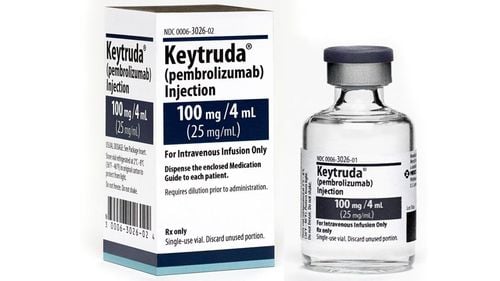This is an automatically translated article.
Multiple myeloma is a type of blood cancer. The incidence of multiple myeloma may be 2-4/100,000. Multiple myeloma usually occurs in areas where the bone marrow is still active in adults, such as the skull, spine, ribs, shoulder blades, and pelvis.
1. What is multiple myeloma?
Multiple myeloma is a cancer caused by the excessive proliferation of plasma cells that crowd out normal healthy cells in the bone marrow. When many of these cells accumulate, a tumor forms. The term "multiple myeloma" is used when a patient has multiple tumor formations.
Multiple myeloma usually occurs in areas where the bone marrow is still active in adults, such as the skull, spine, ribs, shoulder area, and pelvis.
Multiple myeloma can be divided into four stages:
Latent stage: This is the very early stage of the disease, when there are no symptoms or problems. Blood and kidneys are normal, no bone damage. People with insidious myeloma usually do not need immediate treatment. Stage I: There are not many myeloma cells in the body. Doctors can't see any bone damage on the X-ray, or the cancer only affects one area of bone. The amount of calcium in the blood is normal. Other blood tests may be just slightly off balance. Stage II: This is intermediate between stage I and stage III. There are more myeloma cells in the body than in stage I. Stage III: There are more myeloma cells and cancer has destroyed three or more areas of bone. Calcium in the blood is high, and other blood tests are abnormal. Doctors can tell what stage you have multiple myeloma by watching your bone X-rays and doing blood, urine, and bone marrow tests. Determining which stage the disease is at is very important in guiding the treatment of multiple myeloma.
2. What are the causes of multiple myeloma?
Researchers haven't determined for sure what causes multiple myeloma. It may be related to changes in DNA.
According to research, there are several factors that increase the risk of the disease including:
Age: Most people with multiple myeloma are over 45. More than half of cases are over 65 years old. Race: The disease is nearly twice as common in African-Americans. Gender: The disease is quite common in men. Overweight status. Heredity: Having a family member with multiple myeloma. History: Previous history of another plasma cell disease.
3. What are the signs and symptoms of multiple myeloma?
In the early stages of multiple myeloma, patients may be asymptomatic or have very mild symptoms. Each patient will have different symptoms and feel the effects of the disease. Common symptoms of multiple myeloma include:
Bone pain, especially in the back, ribs and skull. The body may feel tired and weak. Feeling very thirsty. Frequent infections and fever Changes in frequency of urination. Anxious, bewildered. Nausea and vomiting. Eating is not appetizing. Weight loss . Numbness, especially in the legs. Multiple myeloma can affect a person's body in different ways:
Bones: This disease can make a person's bones weak and fragile. Blood: Because bone marrow makes blood, multiple myeloma can affect a person's healthy blood cell counts. Anemia: Too few red blood cells make the body weak, short of breath, or dizzy. Leukopenia: the patient is susceptible to infections such as pneumonia. Thrombocytopenia: makes it harder for wounds to heal, can bleed too much even in very small cuts. Multiple myeloma can lead to increased calcium in the blood: it can cause abdominal pain or thirst, frequent urination, dehydration, constipation, loss of appetite, weakness, drowsiness, restlessness, maybe even comatose. Kidneys: Multiple myeloma and high calcium levels can damage the kidneys and interfere with blood filtration. Affects the excretion of salts, fluids and waste. Symptoms such as shortness of breath, itching, swollen feet, fatigue.
4. Methods of diagnosing multiple myeloma:
To diagnose multiple myeloma, your doctor will do a combination of tests:
Blood tests:
Complete blood count. Biochemical. Beta2 microglobulin. Types and levels of antibodies/immunoglobulins. Serum protein electrophoresis. Immunoelectrophoresis fixed. Light chain test (Kappa, Lambda, gamma globulin) without serum Urinalysis:
Urinalysis. Protein levels in the urine. Protein electrophoresis, urine immunoassay. Bone and Marrow Tests:
Imaging: X-ray, CT Scan, or MRI Biopsy or bone marrow aspiration. Chromosomes and fluorescence in situ hybridization (FISH)
5. What are the methods used in the treatment of multiple myeloma?
We should know that multiple myeloma is an incurable disease, treatment only helps prolong and improve quality of life. Some of the treatments are as follows:
Immunomodulators: These drugs are treatments for multiple myeloma. They act on the patient's immune system. One part activates certain immune cells and the other part blocks the signals that tell the growing cancer cells to kill the myeloma cells. Proteasome inhibitors: Proteasomes are protein complexes that help cells (including cancer cells) get rid of old proteins so they can be replaced with newer versions. Proteasome inhibitors prevent cancer cells from doing this, so when old proteins accumulate, the cancer cells die. Steroid drugs: These drugs are used at all stages of the disease. High doses can kill many myeloma cells. They are also used to relieve pain symptoms by preventing white blood cells from reaching the affected areas. And they can help ease chemotherapy side effects, like nausea and vomiting. Immunotherapy: This method uses the patient's immune system to fight cancer cells. Chimeric antigen receptor (CAR) T cell therapy involves versions of a patient's immune T cells that have been genetically altered to attach to cancer cells. HDAC inhibitors: These drugs stop multiple myeloma cells from making too much of the protein histone deacetylase (HDAC), which helps malignant cells quickly grow and divide. Monoclonal antibodies: These immunotherapy drugs help your immune system fight cancer. They carry antibodies into your body that target specific proteins on multiple myeloma cells. Chemotherapy: These drugs treat cancer by killing cells that are in the process of dividing. They also kill surrounding healthy cells, causing nasty side effects. Stem cell transplants: There are two types of stem cell transplants for multiple myeloma: Autologous stem cell transplants, which use the patient's own stem cells. Allogeneic stem cell transplantation, using cells from a donor. This type is less common because of the risk of rejection. Patients often receive a transplant in combination with chemotherapy. Radiation: This treatment uses high-energy particles or rays to damage cancer cells and stop them from growing. You get it from a machine that sends high-energy rays into your body. Complementary care: These treatments help manage drug side effects and complications of multiple myeloma. Supportive care: These treatments can make life easier with multiple myeloma. These include physical therapy, nutritional counseling, massage, exercise, and more. End-of-life care: When your condition no longer responds to medication, this option will help control pain and symptoms to keep you as comfortable as possible. Currently, Vinmec International General Hospital is the leading medical facility in the field of detecting cancer-related diseases, in which multiple myeloma can be treated with specific treatment with stem cell transplantation for the treatment of multiple myeloma. Hematopoietic stem cell transplantation is the most radical treatment, the opportunity to help patients with malignant blood diseases, including multiple myeloma, so that patients can recover and lead normal lives.
Please dial HOTLINE for more information or register for an appointment HERE. Download MyVinmec app to make appointments faster and to manage your bookings easily.













